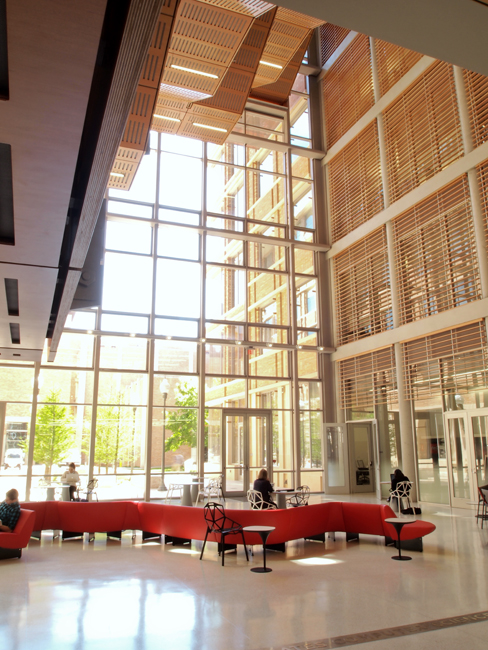The Bill and Melinda Gates Computer Science Complex, which opened March 6, is the latest in a series of new or renovated buildings to populate the East Mall. This part of campus has long played second string to the West Mall’s historic structures and active public spaces, so in order to be considered a success, any change to the area’s stock of buildings must contribute to the invigoration of the eastern part of campus.
The Gates complex, though relatively unassuming from the exterior, manages to inject architectural levity — such as a fifth-floor stairway with a glass floor and orange-tinted windows — into an otherwise standard University building, and contains within it campus’s most inspiring new indoor study space. Though the complex’s restrained color palette, tight symmetry and severe geometry can begin to feel overwhelming, they also endow the building with a formality and sincerity that has been absent from other new buildings on campus.
The site, located on Speedway but separated from the East Mall by the E. P. Schoch Building, lacks the prominence enjoyed by the also recently-built Student Activities Center and Liberal Arts Building. As a result, the Gates Center sits quietly among the surrounding structures. On the Speedway side of the building, it’s easy to see how Fred Clarke — an alumnus of the UT School of Architecture and one of the complex’s lead designers — might have been inspired by the buildings that flank the more prominent South Mall, where small courtyards emerge between relatively simple classroom buildings.
The space between the two wings of the Gates Center is occupied by a Sol LeWitt sculpture that was unveiled on March 21 as part of the campus’s Landmarks public art program. Unlike traditional art, LeWitt’s work consists of meticulous directions or algorithms that other artists follow to bring his artwork to life. Thus, a collector does not buy a LeWitt sculpture or painting, rather the instructions that will lead to its eventual creation — appropriate for a building where so much attention is paid to the underlying codes that make computers work.
Inside, a LeWitt mural injects color into an otherwise gray classroom hallway. And while much of the complex’s interior spaces are painted in cool grays and whites, the extensive use of wood paneling in the atrium located between the two main buildings and the large windows located throughout give the entire complex an inviting feel.
Many of the new buildings on campus — the Belo Center, the Norman Hackerman Building and the Student Activity Center in particular — boast prominent open spaces in which students can gather to study, eat or merely chat. All share some aesthetic similarities: high ceilings, lots of windows, brightly-painted walls and bizarre furniture. The atrium space in the Gates Complex meets several of these criteria, but also manages to create a space that is inspiring to be in, regardless of your purpose for being there.
Four stories worth of open study spaces cantilever out over the first floor lobby, and each of those study rooms are connected by stairways that literally hang within the volume of the atrium. The angular, wood-paneled ceilings emphasize the height and size of the atrium and give it a dynamic feel. The horizontal wooden louvres that flank the atrium’s north and south wall provide teasing glimpses into the windowed offices and classrooms that surround the atrium, allowing the activity taking place within those rooms to further animate the space that they overlook.
Rather than relying on bright colors or strange light fixtures to attract superficial interest, the atrium in the Gates Complex is an inherently interesting space unto itself, with plenty of places upon which to let your gaze linger rather than write the paper you came there to finish, and perhaps even more importantly, plenty of outlets from which to charge your laptop.
Like other inspiring study areas on campus — the Architecture and Life Sciences libraries, for example — the care and detail in the design of the Gates Complex’s central atrium is tactile evidence of someone’s significant effort. In the words of the Chair of the Computer Science Department, Bruce Porter, the space encourages those who study in it or merely move through it to “raise their game.” That statement applies equally well for the architects designing campus’ next new building.
Finke is an architecture and urban studies senior from Houston.





















